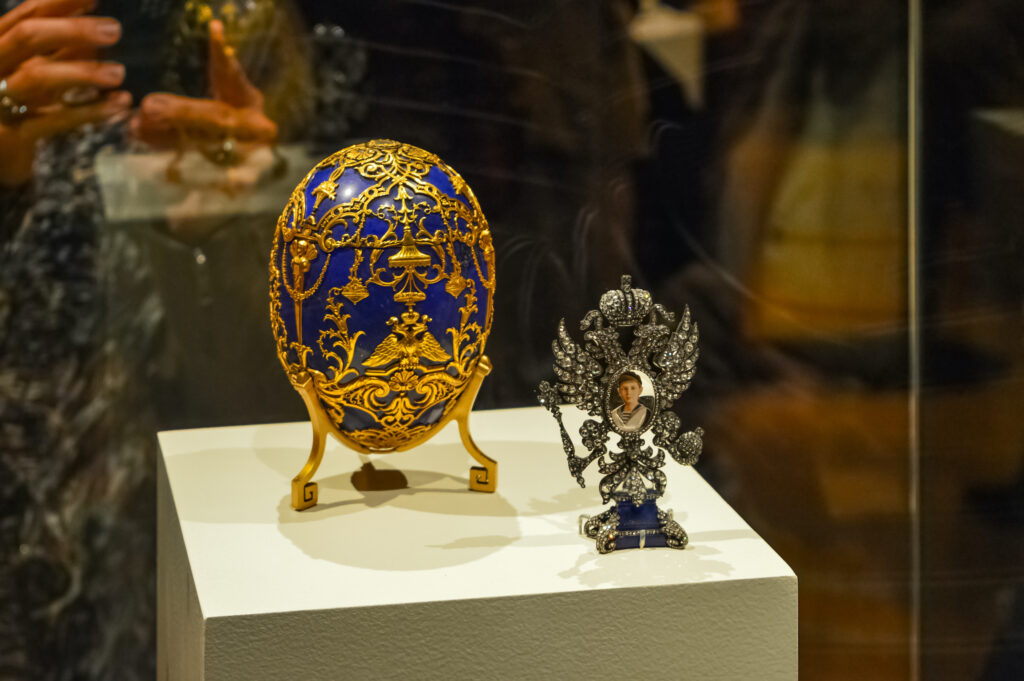Few objets d’art have the allure and mystery that Fabergé eggs do. Initially commissioned as gifts by Russian tzars, they have become renowned for their beauty and intricacy, not to mention their great monetary value.
Imperial Fabergé eggs were crafted from 1885 to 1917, following which almost a century passed before another Fabergé egg was crafted. The year 2015 marked the creation of Fabergé’s first Imperial-style egg since the Russian Revolution.

These exceptional eggs continue to captivate the art world with their extensive history, superior craftsmanship, and elements of mystery regarding the whereabouts of certain eggs.
The origins of Fabergé eggs
The origins of these exquisite pieces stem back to 1885. Tzar Alexander III commissioned Peter Carl Fabergé, a master goldsmith, to create an Easter egg for the tzar’s wife in 1885.
Peter Carl Fabergé was in charge of the House of Fabergé, a company known for expertly crafting jewelry. He created an object designed to surprise and delight in equal measure.
The white enameled egg revealed beautiful objects within including a golden yolk, inside of which was a golden hen. Even the hen itself contained a small diamond crown and an even smaller ruby pendant egg.
The Hen Egg was proceeded by a second commission the following year, and so an annual tradition was established that would ultimately result in 50 Imperial Easter eggs being commissioned by Tzar Alexander III and Tzar Nicholas II.
While Fabergé initially designed the eggs according to Tzar Alexander III’s directions, he was subsequently given the freedom to design the eggs as he saw fit, providing that they each contained a surprise.
This gave Fabergé the freedom to create and craft exceptional pieces, each of which was tailored to the recipient. From 1885 to 1893 ten eggs were crafted for Tzar Alexander III’s wife Maria Feodorovna, while a further forty eggs were crafted up until 1916 under Tzar Nicholas II’s reign.
During Tzar Nicholas II’s reign, two eggs were crafted each year; one for his mother and one for his wife Alexandra Feodorovna. The Rosebud Egg was the first to be gifted by Tzar Nicholas II to his wife and was presented to her a few months into their marriage.
The Coronation Egg created in 1897 is arguably one of Fabergé’s most famous eggs and served as a memento for the royal pair’s joint coronation. Inside it contained a beautiful golden carriage amongst its treasures.
Revolution changes the course of tradition
No eggs were commissioned during 1904 and 1905 during Russia’s war with Japan. However, the commissions restarted in 1906 and continued annually until 1917 when Tzar Nicholas II was forced to abdicate.
The Imperial eggs were relocated by the Bolsheviks to the Kremlin but the Russian economy fared poorly over the next two decades and the country’s leaders began to sell the eggs to buyers located outside Russia in order to raise money.
Nowadays the majority of Fabergé eggs can be found at the Kremlin Armory which contains ten eggs, the Fabergé Museum in St. Petersburg which houses nine eggs, the Virginia Museum of Fine Arts which has five eggs, the Royal Collection in London which has three, and New York’s Metropolitan Museum of Art which also has three eggs.
Eight Fabergé eggs are still missing, with their whereabouts unknown, though the 1889 Necessaire Egg was last seen in London in 1949, and the 1888 Cherub With Chariot Egg was apparently exhibited at a New York department store in 1934.
A century of change and new Fabergé eggs
During the century that followed, the Fabergé history was marked by many turning points. Peter Carl Fabergé left Russia and the Fabergé name was later used as a trademark across a diverse range of products over the subsequent decades.
However, in 2007 Fabergé Limited completed the acquisition of Fabergé trademarks, licenses and rights related to the Fabergé name and Fabergé was relaunched in 2009. Jewelry and watch collections followed, but most intriguing for egg enthusiasts was the creation of a new Fabergé egg in 2015.
The Fabergé Pearl Egg marked the first egg to be handcrafted in the Imperial style since the Russian Revolution. The egg was made in collaboration with Hussain Ibrahim Al-Fardan, a Qatari businessman and pearl collector. The Pearl Egg features an exterior made from mother-of-pearl and is decorated with 3305 diamonds, 139 white pearls, and a unique 12.17 carat natural gray pearl.
In 2018 Fabergé and Rolls-Royce collaborated to create the Spirit of Ecstasy Egg. Just the second Imperial-style egg commissioned since 1917, the interior features a statue of Rolls-Royce’s iconic mascot, sculpted by hand.
